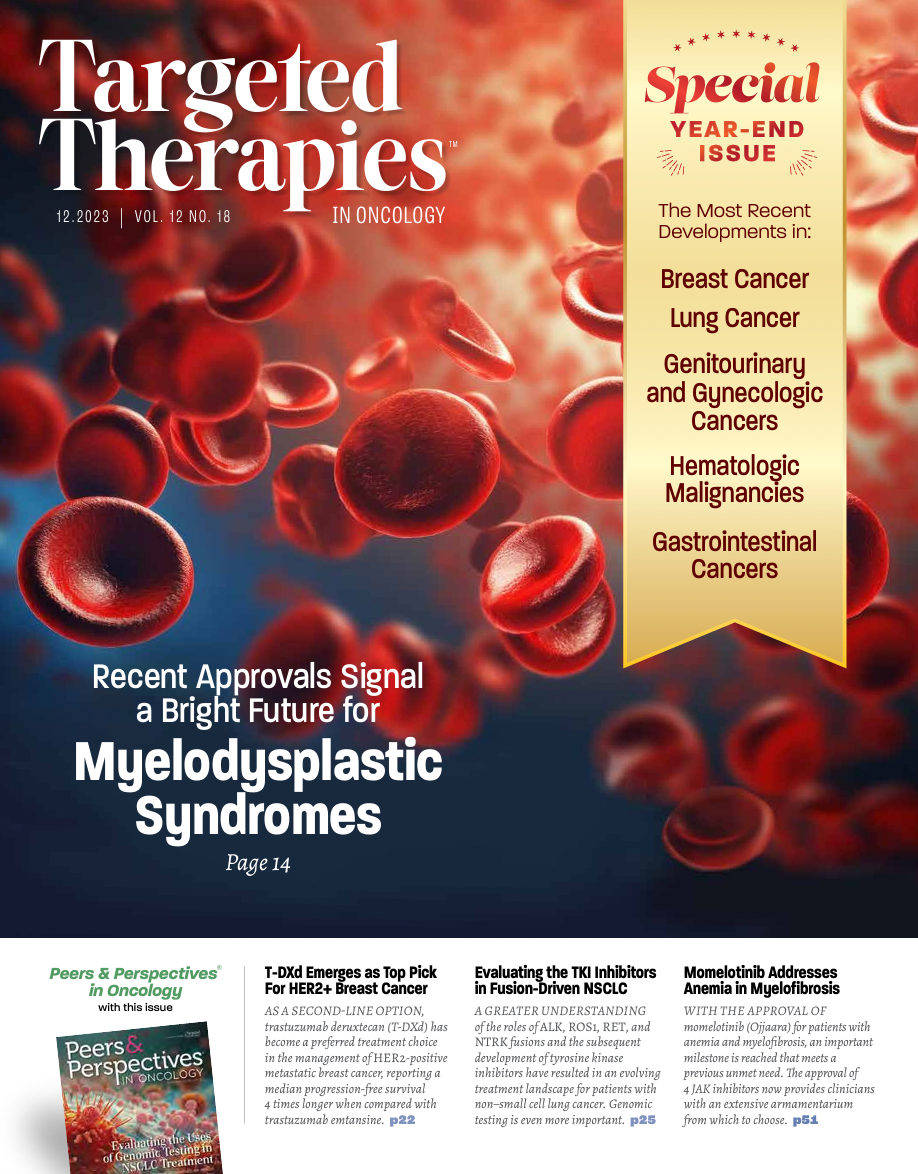Determining Optimal IO Combinations in Advanced NSCLC
Sarah B. Goldberg, MD, MPH, presented these findings to demonstrate the effective time to use immuno-oncology combination therapy during the 41st Annual Chemotherapy Foundation Symposium Innovative Cancer Therapy for Tomorrow.

A number of frontline therapies for advanced non–small cell lung cancer (NSCLC) exist, but determining the optimal therapy from the immuno-oncology (IO), chemotherapy, and IO-chemotherapy combinations currently available can be a daunting undertaking.
When evaluating IO combinations, the combination of ipilimumab (Yervoy) and nivolumab (Opdivo) has favorable 6-year survival outcomes regardless of PD-L1 status when compared with nivolumab plus chemotherapy or chemotherapy alone. Patients with a PD-L1 status of 1% or greater exhibited a 12-month overall survival (OS) rate of 22% with ipilimumab/nivolumab, compared with 15% in the nivolumab plus chemotherapy arm and 13% in the chemotherapy-alone arm. Furthermore, individuals with a PD-L1 status of less than 1% reported a 72-month OS rate of 16% when treated with ipilimumab/nivolumab, compared with 10% in the nivolumab plus chemotherapy arm and 5% in the chemotherapy-alone arm. Sarah B. Goldberg, MD, MPH, presented these findings to demonstrate the effective time to use IO combination therapy during the 41st Annual Chemotherapy Foundation Symposium Innovative Cancer Therapy for Tomorrow, held on November 8 to 10, 2023.1
“The advantages of using ipilimumab alone or in combination with nivolumab over chemotherapy are evident across varying PD-L1 expression levels. This is consistently observed in both PD-L1–positive and –negative cases, highlighting the superiority of the ipilimumab/nivolumab combination over chemotherapy. [Although] the FDA approval for this regimen extends to patients with metastatic lung cancer featuring PD-L1–positive disease, the trial design and analyses emphasize its efficacy, and the benefits appear to extend even to patients without PD-L1 expression,” Goldberg explained. Goldberg is an associate professor of internal medicine, associate director of the Medical Oncology–Hematology Program, division chief of Thoracic Oncology and research director in the Center for Thoracic Cancers at Yale School of Medicine in New Haven, Connecticut.
Sarah B. Goldberg, MD, MPH

The open-label, phase 3 CheckMate 227 trial (NCT02477826) was divided into 2 parts. In parts 1a and 1b, patients were randomly assigned in a 1:1:1 fashion across the 3 arms and were stratified according to tumor type of either squamous or nonsquamous. Investigators reported that the median duration of OS for patients with a PD-L1 level of 1% or more was 17.1 months (95% CI, 15.0-20.1) in the ipilimumab/nivolumab arm vs 14.9 months (95% CI, 12.7-16.7; P=.007) in the chemotherapy arm. For every patient, regardless of their PD-L1 status, the median OS was 17.1 months (95% CI, 15.2-19.9) with ipilimumab/nivolumab and 13.9 months (95% CI, 12.2-15.1) with chemotherapy.
In part 1a, patients received either a dose of 3 mg of nivolumab per kilogram of body weight every 2 weeks plus a dose of 1 mg per kilogram every 6 weeks of ipilimumab, or a 240 mg dose of nivolumab monotherapy every 2 weeks, or up to 4 cycles every 3 weeks of platinum-doublet chemotherapy. In part 1b, patients received the same dose of ipilimumab/nivolumab, or nivolumab (360 mg every 3 weeks) plus platinum- doublet chemotherapy (every 3 weeks for up to 4 cycles), or platinum-doublet chemotherapy alone (every 3 weeks for up to 4 cycles).2
Goldberg explained that there are subgroups who may not benefit from combination IO, which was demonstrated in the Lung-MAP trial (NCT02785952)3 and the KEYNOTE-598 trial (NCT03302234).4
In the Lung-MAP trial, patients were pretreated with chemotherapy for stage IV squamous cell carcinoma and received ipilimumab/nivolumab in the second line, compared with nivolumab alone. The median survival was 10 months (95% CI, 8.0-14.4) in the ipilimumab/nivolumab group and 11 months (95% CI, 8.6-13.7) in the nivolumab-alone group. Study investigators reported an HR of 0.87 (95% CI, 0.66-1.16; P =.34) and the trial was closed due to inefficacy.3
For the KEYNOTE-598 trial, all patients had a PD-L1 level of 50% or greater and received the IO combination of pembrolizumab (Keytruda) plus ipilimumab. However, the combination showed no significant improvement when compared with pembrolizumab plus placebo, reporting an HR of 1.08 (95% CI, 0.85-1.37; P =.74) and a median progression-free survival (PFS) of 8.2 months in the combination arm vs 8.4 months (HR, 1.06; 95% CI, 0.86-1.30; P =.72) in the pembrolizumab plus placebo arm.4
Regarding quadruplet therapy, Goldberg highlighted data from the CheckMate 9LA (NCT03215706) and Poseidon (NCT03164616) trials, which showed an improvement for patients with a PD-L1 expression of 1% or lower “which is interesting,” she said.5
The CheckMate 9LA trial evaluated first-line nivolumab and ipilimumab and 2 cycles of chemotherapy compared with chemotherapy alone, reporting an OS of 15.6 months (95% CI, 13.9-20.0) in the combination arm vs 10.9 months (9.5-12.6) with an HR of 0.66 (95% CI, 0.55-0.80) in the chemotherapy-alone arm.6
The Poseidon trial evaluated durvalumab (Imfinzi) with or without tremelimumab (Imjudo) plus chemotherapy compared with chemotherapy alone in a 3-arm trial. Investigators reported a PFS with an HR of 0.72 (95% CI, 0.60-0.86; P =.0003) and a 24-month OS rate of 32.9% vs 22.1% in the durvalumab/tremelimumab/chemotherapy combination arm vs chemotherapy alone.7
“For patients with high PD-L1 levels, I aim for single-agent therapy when feasible. However, if the patient is a never-smoker or exhibits a high tumor or symptom burden, I lean toward a combination with chemotherapy. For patients with PD-L1 levels of 1% or greater, the preferred strategy is combining chemotherapy with immune therapy. For those with PD-L1 levels below 1%, a combination becomes crucial,” Goldberg explained.1
REFERENCES
1. Goldberg SB. Frontline therapies for advanced NSCLC (IO vs chemo vs chemo-IO). Presented at: Chemotherapy Foundation Symposium Innovation Cancer Therapy for Tomorrow; November 8-10, 2023; New York, NY.
2. Hellmann MD, Paz-Ares L, Bernabe Caro R, et al. Nivolumab plus ipilimumab in advanced non–small-cell lung cancer. N Engl J Med. 2019;381(21);2020-2031. doi:10.1056/ nejmoa1910231
3. Gettinger SN, Redman MW, Bazhenova L, et al. Nivolumab plus ipilimumab vs nivolumab for previously treated patients with stage IV squamous cell lung cancer: the Lung-MAP S1400I phase 3 randomized clinical trial. JAMA Oncol. 2021;7(9):1368-1377. doi:10.1001/jamaoncol.2021.2209
4. Boyer M, Şendur MAN, Rodríguez-Abreu D, et al; KEYNOTE-598 Investigators. Pembrolizumab plus ipilimumab or placebo for metastatic non–small-cell lung cancer with PD-L1 Tumor Proportion Score ≥50%: randomized, double-blind phase III KEYNOTE-598 study. J Clin Oncol. 2021;39(21):23272338. doi:10.1200/JCO.20.03579
5. Liu Y, Cheng X, Han X, et al. Global research landscape and trends of lung cancer immunotherapy: a bibliometric analysis. Front Immunol. 2022;13:1032747. doi:10.3389/fimmu.2022.1032747
6. Paz-Ares L, Ciuleanu TE, Cobo M, et al. First-line nivolumab plus ipilimumab combined with two cycles of chemotherapy in patients with non-small-cell lung cancer (CheckMate 9LA): an international, randomised, open-label, phase 3 trial. Lancet Oncol. 2021;22(2):198-211. doi:10.1016/S14702045(20)30641-0
7. Johnson ML, Cho BC, Luft A, et al; POSEIDON Investigators. Durvalumab with or without tremelimumab in combination with chemotherapy as first-line therapy for metastatic non-small-cell lung cancer: the phase III POSEIDON study. J Clin Oncol. 2023;41(6):1213-1227. doi:10.1200/JCO.22.00975
